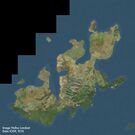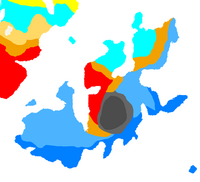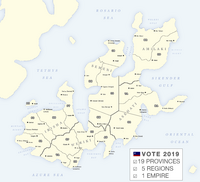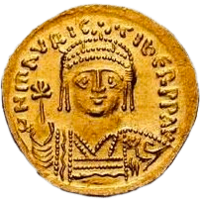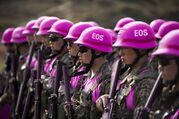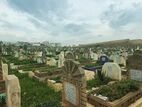Orioni: Difference between revisions
m (→Communication) |
|||
| Line 260: | Line 260: | ||
[[File:Administrative divisions of Orioni.png|200px|thumb|Regions and provinces of Orioni for the 2019 election.]] | [[File:Administrative divisions of Orioni.png|200px|thumb|Regions and provinces of Orioni for the 2019 election.]] | ||
The bureaucratic administration of Orioni is divided into four basic levels. Following the {{wp|Nomenclature of Territorial Units for Statistics}} (NUTS), these levels are: country, region (NUTS-1), province (NUTS-2), and municipality (LAU). Below the national government, there are 5 regions, further divided into 19 provinces. | The bureaucratic administration of Orioni is divided into four basic levels. Following the {{wp|Nomenclature of Territorial Units for Statistics}} (NUTS), these levels are: country, region (NUTS-1), province (NUTS-2), and municipality (LAU). Below the national government, there are 5 regions, further divided into 19 provinces. Regions do not have elected officials, nor are they corporate bodies. But the practice of ordering provinces based on their geographic region is traditional. Every province has its own head of the executive branch (governor), a legislative parliament, and a constitutional court. The governor is directly elected. Their considerable practical powers are moderated by the legislature. | ||
* '''Weriki''' (central) forms the core of the empire, with its ancient traditions and ageless monuments. It is the geographic location of the first {{wp|tribe}}s that banded together before politically uniting the entire island. Weriki has: the highest annual precipitation, fewest sunshine hours, smallest area, highest energy consumption, largest population, and hottest summers. | * '''Weriki''' (central) forms the core of the empire, with its ancient traditions and ageless monuments. It is the geographic location of the first {{wp|tribe}}s that banded together before politically uniting the entire island. Weriki has: the highest annual precipitation, fewest sunshine hours, smallest area, highest energy consumption, largest population, and hottest summers. | ||
Revision as of 19:40, 3 October 2022
Introduction
Orioni Empire Erwaniye Sibaniye (Oharic) | |
|---|---|
| Motto: Libertati Viam Facere | |
| Anthem: Freedom's Sun | |
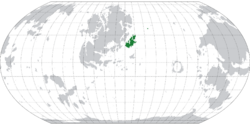 Location of Orioni on Eurth. | |
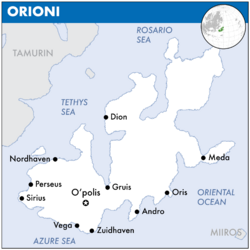 Map of Orioni | |
| Capital |
|
| Largest city | Zuidhaven |
| Official languages | Oharic |
| Recognised national languages | Anglish |
| Recognised regional languages | Meharic; Buranic |
| Ethnic groups | Medanese |
| Demonym(s) | Orinese |
| Government | Unitary parliamentary constitutional monarchy |
• Empress | Joni I Nabérrie |
• Chairperson | Awidefale Rezovi |
| Legislature | Sibiseba |
| Formation | |
• Queendom | 980 BCE |
• Empire | 536 BCE |
• Restored Empire | 1175 CE |
| Area | |
• Total | 1,139,811 km2 (440,083 sq mi) |
• Water (%) | 4.20 |
| Population | |
• 2018 estimate | 144,800,000 |
| GDP (nominal) | 2018 estimate |
• Total | 5,632,000,000 |
• Per capita | 38,894 |
| Gini (2013) | 35.1 medium |
| HDI (2018) | very high |
| Currency | Orinese Phi (ORP (Φ)) |
| Time zone | UTC+9 to +10 |
| Antipodes | Oyus |
| Date format | dd/mm/yyyy |
| Driving side | right |
| Calling code | + |
| ISO 3166 code | OR |
| Internet TLD | .io |
This article is incomplete because it is pending further input from participants, or it is a work-in-progress by one author. Please comment on this article's talk page to share your input, comments and questions. Note: To contribute to this article, you may need to seek help from the author(s) of this page. |
The Orioni Empire, commonly referred to as Orioni (o·ri·o·ni; pronounced /ɒɹiːɒniː/ or oh-ree-oh-nee), is an island nation off the eastern coast of the Europan continent on Eurth. Nearby neighbours include Tamurin to the north, Malindi island of Miiros to the east, Niederoestereich to the south, and Mekabiri to the west. Orioni lies on the western side of the Oriental Ocean and stretches from the Rosario Sea in the north to the Azure Sea in the south. It is an environmentally stunning nation. Orioni has a population of approximately 144.8 million, and an area of 1,139,811 square kilometres (440,083 sq mi). Its leaders meet every day in the capital city of O'polis to discuss matters of state.
Orioni is a democracy organised in the form of a parliamentary government under a constitutional monarchy with an elected legislature known as the Sibiseba. Below the national government, there are 5 regions, further divided into 19 provinces. It is difficult to tell where the omnipresent government stops and the rest of society begins, but it juggles the competing demands of Law & Order with social welfare and equality. Orioni is ruled with a fair hand by Her Imperial Highness Joni I Nabérrie. The Constitution of Orioni defines the Empress as “the symbol of the state and the unity of the people."
The Orinese islands were inhabited as early as 8000 BCE. The islands have been a valuable trade hub on the Pearl Road since at least the 6th century BCE when various kingdoms became increasingly united under a centralised government. Azanian scholars and Buranian traders brought foreign influences that were gradually integrated. After nearly two centuries of civil war, the country entered a long period of colonial expansion. In the 14th centuries, a period today referred to as the Age of Reconnection, Orioni began establishing a vast maritime and commercial empire. The 19th and 20th centuries saw the country lag behind in industrialisation and modernisation. Recently the country is marked by rising tension between regions and increased international cooperation.
Orioni is a highly developed country with one of the largest economies in Eurth, supported by a strong maritime-commercial base. The country is notable for its museums and concert halls, daily referendums, devotion to social welfare, and a keen interest in outer space. Orioni is a regional power and the country is a member of several multilateral organisations, including the Entente of Oriental States, Assembled Nations, and the Antargic Council.
Etymology
The original name for Orioni is Erwanin. The accepted etymology is that it means “land of the lady”. In Proto-Europan Erwa means “land”. And the term Nin was used to denote a queen or lady, similar to the ancient Memopotamian cuneiform script. Other related languages use the feminine suffix of -Na or -Ma. The name Erwa-Nin (“land of the queen lady”) is a reference to the earliest political system in Orioni which was a matriarchal tribal monarchy.[1] The name Erwanin also highlights the contrast with mainland Europa where patriarchal societies were dominant. Such patriarchies frequently used the honorific of baba (“father”). Early Orinese referred to these other lands as “Land of the Father” or Erwa-Ba(b) or Eruaba, provided a theoretical and controversial explanation for the present-day name of “Europa”.[citation needed]
In other Oriental countries, there exist two versions of the name: Purana and Haryana. The name Purana (Sanskrit: पुराण, purāṇa) means “ancient, old” and first appeared around 250 CE in the Three Kingdoms of Jaihu, Koku and Ide Jima. The name Haryana is found more to the west in the works of the 2nd-century BCE Shakyan writer Vibudh Shridhar (1189–1230). The name Haryana has been derived from the Sanskrit words हरि (Hari, the Hindu god Vishnu) and अयन (Ayana, “home”), together forming “the Abode of God”. In Sanskrit the title of Maharani is used “for states where a woman is ruling without a husband.” This name comes from Sanskrit महा (mahā, “great”) and रानी (rānī, “queen”). From Proto-Europan *h₃rḗǵnih₂. The noun राज्ञी (rā́jñī) happens to be the “name of the wife of the San”. This is related to Mohini, the female goddess avatar of Vishnu.
The name also appears under several similar forms in other languages. In western Azania, Memopotamia and Occidental Europa, the most distinctive title is Urania, meaning the “queen of the heavens”. This reference to a sky deity likely signifies “she whose seat is in heaven", from which she rules over the known wurld. Other experts have suggested that the name originated from the Hakkadian Uru-anna (“the light of heaven”), the name then passing into Aroman mythology as Ὠρίωνί. Later Aroman sources associate this faraway land with ειρήνη (eiríni, “peace”).[citation needed] In the 9th century BCE, the ancient Suhrabians referred to the nation as Aranu, in the nearby Afropans called them Arauni, and Proto-Jilderen used Ubini (“beautiful people”). The Sahrabic name “Ari” comes from “Aruin”. The name Aaru is used in Qubdi as a reference to a place in the east where the San rises and described as a series of islands with ideal hunting and farming ground like those of the Fiaru River delta, allowing the people there to live forever. In Yehud the name Ori (“my light”) also shows this connection with the San.
Further north, the Buranians didn't come into direct contact with Orioni until much later, during the early Late First Empire. In their writings the Buran frequently use the name (N)ingwi which closely resembles the name for their god of sanshine. At the same time, these Buranians also worshipped Rán as a goddess and personification of the sea. It is unclear if this sea-goddess contains any connection to the name Orioni. Meanwhile, the Salvic languages use the word porane(k) to describe the morning. In Salvic mythology, (Z)oryane is a guardian goddess who opens the gates each morning so that the San may begin its journey. She is a patroness of horses, protection, healing, and the planet Venus. Some later Alemmanic languages follow a different approach, pronouncing the name as “Urin”. This can be short for “Urinsel", a compound of ur- (“original”) and Insel (“island”). This linguistic term denotes the hypothesised prehistorical homeland of some Alemmanic clans. Another Alemmanic source claims the name originated from Hariwini, composed of the elements hari (“respected”) and win (“friend”).
Geography
Orioni is located at the easternmost region of Europa, separated from the Europan mainland by the Tethys Sea and along the Oriental Ocean. At 1,155,853 km2 (446,277 sq mi), according to the AN Geographic Yearbook, Orioni is the 2nd-largest country on Eurth. It is slightly larger than Volsci, twice the size of Tamurin, three times as big as Variota, four times the size of Batengdei and five times the size of the Seylos. The main island, also called the “Home Island", is divided into three parts: western Alnitak where the majority of the Orinese population lives, central Alnilam is dominated by the Mendakh mountains, and northeastern Almintaka forms a sparsely inhabited nature preserve. Besides the main island, there are also 430 smaller islands, of which the larger ones are being inhabited and others remain uninhabited. To the west of Nordhaven lies Deseti island, which hosts the headquarters for the Entente of Oriental States. To the southeast of Oris lies Malindi island which is presently occupied by Miiros.
Mount Silesto in Amilaki at 3,450 m (11,320 ft) is the highest peak in Orioni. Excluding the Rohini and Burkini islands, the country lies between latitudes 15° and 31°N, and longitudes 135° and 152°E. It is south of Ide Jima, separated by the Rosario Sea; and north of Niederoestereich, separated by the Azure Sea. The closest neighbouring country to Orioni is the Tamurin republic westward across the Roavia Strait. Orioni maintains maritime claims on the continental shelf of 200 m depth or to the depth of exploitation. Its territorial sea extends 12 nautical miles (22,2 km or 13,8 mi) with an exclusive economic zone of 200 nautical miles (370 km or 230 mi). The northernmost point is Cape Tawiseni extending into the Rosario Sea, Mar province (30°57'N). The easternmost point is Cape Amrita on the Deli peninsula, Meda province (152°04'E). The southernmost point is an unnamed point in one of the shifting sandbanks of the Wenizi river delta at low tide, Zuidhaven province (15°29'N). The westernmost point is Cape Suzette, Sirius province (134°54'E).
Landscape
About 53% of Orioni is either forested or mountainous, making it largely unsuitable for agricultural, industrial, or residential use. Hill country of over 500 m (1640 ft) above sea-level dominates the Home Island and in some other elevated regions such as central Alnilam even 2000 m (6561 ft). Additional areas are inhospitable to human habitation, such as the coastal deserts of western Alnilam. This means that coastal areas contain habitable zones and have high population densities. The population tends to cluster around fresh-water sources and seaports. As a result, these coastal regions of Orioni are some of the most densely populated areas on Eurth.
The western part of the country contains temperate forestland and rolling hills, with a strong agricultural imprint on the northern plains and along the Firigirigi river. The Wenizi river flows through the western part of the country, its origin located somewhere in the high mountains towards the east. The artificial Owara canal connects the Wenizi with the Firigirigi, enabling shipping to multiple parts of this western region. The canal was built in 1671 by decree of Empress Owara and modernised in around 1900. Between 1895 and 1904, the army engineers enlarged the Owara canal to 25 metres (82 feet) wide and 3 metres (9.8 feet) deep. Empress $name expanded the canal again to 40 metres (130 feet) wide and 4.5 metres (14.8 feet) deep through mountainous rocky terrain.
In the east and south, along the shores of the Azure Sea, are extensive and densely populated alluvial plains of the Wenizi and the Caroni river, combined with lower mountain ranges in the Zinabi valley to the east. This fertile valley in the southeastern part of the country is curtailed by the Dayonisesi mountains, a mountain range that forms an enclosing arc, and also contains the countries highest point, Mount Silesto at 3,450 m.
The northeastern region of Orioni consists of elevated highlands called the Mendakh mountains by the local mountain tribes.
Climate
Orioni has a tropical marine climate that is usually hot and humid. There are three seasons: the hot dry season or summer from March to May; the rainy season from June to November; and the cool dry season from December to February. Temperate easterly winds and southern ocean currents ensure warm summers and very mild winters. Seasons vary per region, with the south being warmer compared to the rainy west and subtropical north. Temperatures usually range from 21 °C (70 °F) to 32 °C (90 °F) although it can get cooler or hotter depending on the season. The coolest month is January; the warmest is May.
The average yearly temperature is around 26.6 °C (79.9 °F). In considering temperature, location in terms of latitude and longitude is not a significant factor. Whether in the extreme north, south, east, or west of the country, temperatures at sea level are in the same range. Altitude usually has more of an impact. The average annual temperature on the Mendakh mountains at an elevation of 1,500 meters (4,900 ft) above sea level is 18.3 °C (64.9 °F), making it a popular destination during hot summers.
Fauna and flora
Fauna in Orioni is quite diverse. The Orinese archipelago has many different animals in all shapes and sizes that are adapted to a wide range in climates and altitudes. About 53% of Orioni is either forested or mountainous. Orioni has a tropical marine climate that is usually hot and humid. The southeastern mountain flanks enjoy a nice climate that allows for vineyards to grow. Lush broad-leaved trees in the northern forest. These lush green giants cover most of the country. Some areas are inhospitable to human habitation, such as the coastal deserts of western Alnilam. The main ecological divide is the one between urban pets versus rural “pets”.
Venture outside any city and you'll meet a much wider variety of animal. The pink dolphin (Inia geoffrensis) is the national animals. They are solitary animals and live primarily in the southern river systems of the Wenizi and Caroni. Pink dolphins are unique among dolphins for having molar-like teeth and can chew their prey. Diet of Orioni river dolphins comprises fish, shrimps and crabs. They also eat piranhas and turtles. Pink dolphins are true carnivores (meat-eaters). Pink dolphins can move from rivers to ponds and lakes during the rainy season (when rivers flood). Some pink dolphins are actually very rare albinos. Albino dolphins can appear pink instead of white because of the blood vessels under their skin. For really wild animals, there's only one place: the northeastern Amilaki Wildlife Reserve established by EOS. It is the least populous region, with the longest coastline, largest area, lowest annual temperature, coldest winters, highest temperature difference between seasons, and most volcanic activity. Head up to Adansi to see a completely different side of the country. The city is located in the mountainous Kidusi province. Elephant rides are a popular activity here, although the practice is sometimes ethically questionable. Tourists love visiting the elephant sanctuaries, transplanted from the Kingdom of Koku, which allow visitors to appreciate these magnificent creatures while providing them with a safe and loving environment at the same time. The cultural influence of animals is widely be debated and certainly not settled. Some non-native animals were imported from former colonies, while enemies also brought animals to Orioni. For example royal processions in the 10th Century CE are known to have included elephants. During the civil war (1023-1174) the mercenaries of Uthman ibn Naissa brought many horses with them, an animals that's not native to tropical Orioni.[2]
Hunting and fishing is regulated on the provincial level. Historically, tigers were hunted to collect their famous striped skins. Tiger hunting took place on a large scale in the early 19th and 20th centuries. It was an admired sport by the continental Europan aristocrats. Tiger hunting was done on foot with with a goat or buffalo as bait. The trade in tiger skins peaked in the 1930s. In some provinces there is a hunting season for boars and deer, which cause large amounts of agricultural damage, until mid-March. In the mountainous provinces there are special hunting clubs in towns and villages. The men raise dogs in order to hunt wild boars in the mountains. The men get dressed up and put on their hats, they load up their dogs in trucks, cars, motorbikes and scooters, and they go hunting. Hunters are required to have gun and trapping licenses. Boar and deer populations continue to climb despite efforts to shrink their numbers Orioni is facing an ageing, declining population that increasingly lacks the energy, interest and funding to cull wildlife.[3]
For the average city dweller without much living space, you have your standard cats and dogs and what have you. School children are allowed to take care of the class aquarium fish. There is also a lively underground network of illegal trade in snakes and other reptiles.
Administrative divisions
The bureaucratic administration of Orioni is divided into four basic levels. Following the Nomenclature of Territorial Units for Statistics (NUTS), these levels are: country, region (NUTS-1), province (NUTS-2), and municipality (LAU). Below the national government, there are 5 regions, further divided into 19 provinces. Regions do not have elected officials, nor are they corporate bodies. But the practice of ordering provinces based on their geographic region is traditional. Every province has its own head of the executive branch (governor), a legislative parliament, and a constitutional court. The governor is directly elected. Their considerable practical powers are moderated by the legislature.
- Weriki (central) forms the core of the empire, with its ancient traditions and ageless monuments. It is the geographic location of the first tribes that banded together before politically uniting the entire island. Weriki has: the highest annual precipitation, fewest sunshine hours, smallest area, highest energy consumption, largest population, and hottest summers.
- Asehayi (east) is geographically similar to the central region, but it is less populous because of the more arid climate. The rough inland geography encourages a more seaward attitude. Asehayi has: the most landslides, highest altitude, and wettest winters.
- Irisha (west) has always followed a more continental approach, influenced by its proximity to the Europan mainland across the Tethys Sea. It is agriculturally important thanks to the fertile land of the Western Plains. Irisha has: the largest forest area, lowest altitude, coolest summers, mildest winters.
- Semeni (north) is the most mountainous region, dominated by the Mendakh mountains. Rich in minerals, its mining enterprises provide most resources for the nation's industrial activity. The many rivers and coastal roads enhance accessibility, supported by a railroad network along the coast. Semeni has: the lowest annual precipitation, most erosion, most mineral resources, most climate diversity, highest annual temperature, most greenhouse farming, driest summers, smallest forest area, and most sunshine hours.
- Amilaki (northeast) is the least populous region. Most of the area is part of the Amilaki Wildlife Reserve established by EOS. Amilaki has: the longest coastline, largest area, lowest annual temperature, coldest winters, the highest temperature difference between seasons, most volcanic activity, and smallest population.
From north to south, the provinces of Orioni and their commonly associated regions are:
| █♦█ Amilaki region | █♦█ Semeni region | █♦█ Irisha region | █♦█ Asehayi region | █♦█ Weriki region |
|---|---|---|---|---|
During the 20th century, Orioni claimed numerous neighbouring countries and regions in Europa, Thalassa and Marenesia were “lost provinces” of Orioni. Many of these “lost provinces” were under the rule of Imperial Orinese dynasties or were former tributary states. Empress $name claimed in $year that these provinces were lost because of unequal treaties, forceful occupation and annexation, and foreign interference. These former provinces include Rohini, Burkini, the outlying islands of Miiros.
History

Archaeological evidence suggests that prehistoric humans related to Marenesian Aborigines inhabited Orioni from 8000 BCE. Wall paintings of the Arcana culture were found at the archaeological site of Arcan on the southern side of the Altais mountains in western Orioni, where thousands of objects were discovered in 1857. Decorated pottery was dated to be from about 6500 to 5300 BCE. Sometime during the late 5th millennium BCE, the Amari people settled in Orioni, arriving from the east and spreading across the entire island. The Amari people weren't native to the Orioni islands. By 4800 BCE, they are believed to have become the politically dominant ethnic group. Early Amari residents lived in mud-brick houses, stored their harvest in granaries, and created a system of roads radiating out from their great house sites. By 1800 BCE major port cities started to form on a long and narrow strip along the Azure Sea. The early city-states never constituted one political unity, but likely shared a cultural identity between the peoples based on a common language. Each major city was ruled by a monarch in cooperation with representatives of merchant families.
The Medani empire represented the first major centralised nation state. By the 18th century BCE, the Medanese ruled the eastern peninsula and adjacent coastlines, exploiting rich hinterlands as well establishing a reputation as experienced sailors. By the 11th century BCE their westward expansion led to a conflict with the tribal Nairi confederation. According to transcribed oral traditional, Lady Anahita of newly-formed Erwanin queendom halted the Medanese expansion by warring against the Medanese province of Tigrai. The takeover of Tigrai goldmines led to increased wealth and access to the rich coastal port of Ophir. Her descendants expanded the early Erwanin territory towards along southern coasts, into western lands and finally into the east. More provinces of the weakened Medanese dynasty were subjugated, and in 536 BCE Medanese capital itself was conquered by Erwanin.
Queen Nintoku proclaimed herself the First Empress of Orioni. She merged their collective navy and promoted expansionism to gain more lands for its people. The Orioni empire was uniquely situated for success, along the commercial route between the Memopotamia, the Aroman Empire and the Far Eastern states. The Queendom also regularly entered the politics of the kingdoms on the nearby Europan mainland, establishing colonies in Tamurin and Mekabiri. This created a common cultural identity with a distinctive Orinese mark. The Imperial title was passed down through a matriarchal succession, from mother to daughter. At the same time, Orinese curtailed male authority, removing previous male leaders from the royal lists and making sure that no man held multiple royal titles. The orinese islands became a valuable trade hub on the Pearl Road since at least the 6th century BCE when various kingdoms became increasingly united under a centralised government. Azanian scholars and Buran traders brought foreign influences that were gradually integrated. After nearly two centuries of civil war, the country entered a long period of colonial expansion. In the 14th centuries, a period today referred to as the Age of Reconnection, Orioni began establishing a vast maritime and commercial empire. The Empress Fuyami began sending forth explorers to eastern and southern Europa. Religious and linguistic influence spread in these various regions and among the peoples.[4] The 19th and 20th centuries saw the country lag behind in industrialisation and modernisation. Recently the country is marked by rising tension between regions and increased international cooperation.
Politics
Monarchy
The head of state has always been a member of the imperial family. Leadership passes on via matriarchal blood ties: it’s inherited from mother to daughter, sister or niece. Note that the empress does not always have to die to pass on the title; old age or illness are also reasons. For as long as Orioni existed, there has always been a woman to lead them. The empress receives the honorary title of “Orioni”, representing a personification of the entire country by a single person. The current monarch came to power at a rather young age because of the sudden and unexpected death of her mother on March 1st, 2003.
[5] Since then, the young royal had a turbulent time learning to balance on the ropes of the international scene. Aristocracy removes a few select individuals from the daily economic competition to raise them for the office of government. These responsibilities demand an extraordinary education that no conventional education can give. As such, the aristocracy is a garden for government, a repository for rulers, a cradle for culture. It works as a conservative force against short-term fads or erratic variations in the moral code.
Government
The government is organised into three significant levels: national, provincial (Oharic: Kifile), and municipal (Oharic: Kibite). Elections happen every 5 years for each of these levels of government. In the 2015 election for the Sibiseba, the most popular party was the SPO which won 46% of the vote. The next four most popular parties were Blueropa (35%), Pink! (12%), the PO&N (5%), and the Fronde Verdur (2%). In the national election, a total of 103.966.194 votes were cast (out of 80.34% voting age population), and the voter turnout was 89.37%. Provincial autonomy is extensive. The Imperial level takes command of most international affairs such as defence, commerce and foreign affairs.
The government comprises three branches of government. These three branches apply checks and balances to each other.
Legislative branch. The Sibiseba (Anglish: Assembly) serves as the legislative body of the nation. It is a unicameral system. The Sibiseba exists as the legislative body between the different provinces. The Sibiseba votes on provincial disputes brought before it based on what is best for the whole population. During the 19th century, the Sibiseba's powers came to include all important matters of state, including its representation in international organisations, declarations of war against an enemy, and offering military and technological aid to an ally. Each Sibisebali (Assembly person) represents a single constituency within the empire. Each Sibisebali serves a four-year term. The number of constituencies is re-evaluated before each election, thus altering the number of Sibisebali every four years. The 1923 Constitutional amendment instituted the Crown Council, an additional advisory body of membership by right (senator de drept) which is consulted in extraordinary matters. It is composed of the constitutional Monarch, the heir to the throne; former chairpersons of the Imperial Council, except for those who were impeached from office; former councillors with at least five years’ seniority; former judges of the Palace of Justice; the Governor of the National Bank of Orioni; heads of state-recognised religious bodies; the president of the Andro Academy; retired five-star military officers.
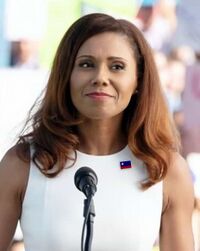
Executive branch. The Imperial Council (Oharic: Memakiriti) holds imperium, “the power to rule", and is the ruling body of the executive branch. The council informs the Monarch on policy matters. The council comprises twelve councillors, chaired by 1 chairperson, and divided over three topical sub-councils. It meets to discuss matters of state in the capital city of O'polis. After each election, the winning parties form a coalition government and appoint an executive cabinet. Chairlady of the Council is Awidefale Rezovi. She is a former mayor of Gruis and a member of the Socialist Party of Orioni, the largest political party.
Judicial branch. The highest court is the Palace of Justice, which comprises twelve justices. The court deals with imperial and constitutional matters and can declare legislation or executive action made at any level of the government as unconstitutional, nullifying the law and creating a precedent for future law and decisions. Below the Palace of Justice is the Hall of Justice, and below these are the House of Justice, which handles the general trial courts of law. The judicial branch organises on a scale equal to the three is of government (imperial, provincial, municipal).
Political parties
The legislative branch of government comprises many political parties, be they centrist, progressive, conservative, nationalist or other. These parties form coalition governments. Although very rare, a minority government is possible if election results make a majority coalition impossible. More often, a minority government forms when one of the council’s coalition partners withdraws its support, or when all councillors of a council party resign. In these cases, the Chairperson offers the full council’s resignation to the Monarch. The Empress may dissolve the Sibiseba and hold a general election. If the Empress does not dissolve the Sibiseba, the remaining cabinet continues as a minority cabinet, in full possession of its powers.
| Party | Position | Ideology | Leader | Seats in the Sibiseba | Coalition |
|---|---|---|---|---|---|
| SPO |
Left-Wing | Democratic Socialism | Mrs Eremi Ciris | 161 / 350
|
|
| Blueropa |
Center-Left | Liberalism | $Name | 123 / 350
|
|
| Pink! |
Center-Left | Green politics | Mrs Ihova Myna | 42 / 350
|
|
| PO&N |
Center-Right | Conservative corporatism | Mr Edric Kageni | 17 / 350
|
|
| Fronde Verdur |
Far-Right | National Conservatism | Mrs Nigela Merabiya | 7 / 350
|
Foreign relations
The foreign relations of Orioni are controlled by the Council of Foreign Affairs of Orioni. Councillor of Foreign Affairs Anna Hackney and former permanent representative to the Entente of Oriental States leads the diplomatic efforts of the Empire. Chairlady Awidefale Rezovi appointed her after the retirement of log-time FA Cllr Sri Andrew Pipkin KBE in 2019. The country maintains diplomatic relations with all sovereign states unless noted otherwise. Orioni is a regional power in the Orient without possessing regional hegemony. During what is considered the Medieval Period in other regions, Orioni took part in the Pearl Road trade network along the entire southern coast of Europa. The earliest official Orinese foreign relations occurred after the Orinese Civil War in the 13th century. It was focused on gaining control over areas in nearby Amutia and Azania. A former colonial power, Orioni's relative power has decreased since the end of the colonial age.
Military
The military doctrine of Orioni puts great emphasis on naval superiority in home waters and providing escorts for commerce vessels, which are the lifeline of the island nation. The navy and army have a higher priority, while the air force has only a secondary role. The overall strategic military command rests with the Imperial Orinese Command Centre (IOCC) based northeast of the capital O'polis. After years of costly military build-up, the military now has a state of readiness capable of responding to all threats, both foreign and domestic.
Ahold Bruiser, Supreme Commander (SC) of the Imperial Orinese Defence Force (IODF), is the senior officer leading the entire armed forces of Orioni, subordinate only to the Empress. Bruiser entered the national spotlight after his involvement in the Great Pot Wars of 2004. He is a member of the Council of Defence, and a such helped to create the Orioni Special Reconnaissance Unit (OSRU), a unit to “meet the growing need for a special reconnaissance capability” with “a wide range of specialist skills and activities related to covert surveillance.” Their missions and interventions remain classified.
The army and special forces are considerable and receive diverse training to deal with the empire's varied geography. One well-known corps is the Mendakh Mountain Troops stationed at Tauri Military Base. Orioni's military strength lies in its powerful blue-water navy, comprising 8 fleets. Grand Admiral Mario Ramius is the highest-ranking and most senior admiral of the Imperial Navy. Ramius rose to prominence during the conflict with S.S.S.S. in 2004. His final promotion to admiral of the fleet following exemplary leadership during the crisis surrounding Tarragat Island in 2006. The chink in Orioni's armour has always been its dated air force. Lacking the necessary experience in aerial combat, the empire prefers investing in anti-aircraft weaponry. Peripheral radar and early warning systems based on EOS cooperation have become a key defence strategy.
There are five major military installations throughout Orioni.
- Vega Naval Base (central), the key to ensuring the safety and security of Zuidhaven, is home to the 1st and 2nd fleet.
- Perseus Naval Base (west), by far the largest military installation, is home to the 3rd, 4th and 5th fleet.
- Dion Naval Base (north), protecting the important mining and industrial areas, is home to the 6th and 7th fleet and the Orioni Special Reconnaissance Unit.
- Oris Naval Base (east) is home to the 8th fleet.
- Tauri Military Base (northeast) makes an ideal proving ground thanks to its remote location and is home to the Mendakh Mountain Troops.
Economy
Orioni has a partially regulated market economy with its feet firmly planted in the international system. But next the other hand, it holds a deep sense of connection to its traditional insular past. Based on market exchange rates it is today the third-largest in Europa, after Miiros and Tagmatium, with a GDP of Φ5,632,000,000 in 2018. The nominal GDP per capita was Φ38,894 (at market exchange rates) in 2018. The currency in use in Orioni is the Orinese Phi (Φ). Throughout its history, Orioni has been involved in trade due to its location, size and natural resources. Tagmatine and Suverin traders brought Occidental produce to the island, in exchange for $resource.
Economic growth has spurred on the development of large skyscrapers around the nation, including the 400 meters high Imperial State Building in O’polis. Most economic development is located in Orioni’s west and central regions, while the eastern region (except for the Meda metropolitan area) is considered more rural and less developed.
The common people of Orioni mostly made a living in agriculture, especially as rice farmers, however, some may have pursued other careers, such as hunter, trader, artisan, weaponsmith, sailor, soldier, dancer, musician, food or drink vendor, etc. Rich portrayals of daily life in the 9th Century can be seen in many temple bas-reliefs. Rice cultivation had become the base for the kingdom's economy where the villages throughout the realm relied on their annual rice yield to pay taxes to the court. Exploiting the fertile soil of Central Orioni and the intensive wet rice cultivation enabled the population to grow significantly, which contributed to the availability of labour and workforce for the state's public projects. Certain villages and lands were given the status as Amisti lands awarded through imperial edict written in inscriptions. The rice yields from Amisti lands usually were allocated for the maintenance of certain religious buildings. Most of the port cities in Semeni, between Dion and Gruis, are surrounded by deserts with scattered pockets of productive land. They lack hinterlands that can support a vibrant market economy and shipbuilding industry.
The first legal casino in Orioni, the Yegili Bota, started operating in 1863 in Zuidhaven. It was converted from a warehouse into a government-owned gambling house. Earlier gambling happened mostly off-shore on ships in the port. This idea still exists in the form of casino cruise ships. Gambling is strictly regulated now. Sports betting exists, which is why sports are generally associated with illegal gambling. There is a consensus among the scholars of Elitism that gambling is sinful and should be forbidden. Elite jurists describe gambling as harmful to the community.[6]
Currency
The National Bank of Orioni is responsible for issuing notes and coins in the nation's currency, the Orinese Phi (symbol: Φ; ISO code: ORP). The currency was adopted in 1893 and is subdivided into 100 Phili. The Phi is the world's fifth-largest reserve currency.
The Orinese started using money in the 2nd century BCE. Medanese perfumes have been discovered as far away as Aroma, suggesting that the famous Pearl Road was already emerging. A currency was still a novel idea at the time. Previously it was shaped like dolphins, unique in shape, which seems inconvenient. Interestingly, the early Orinese adopted an ingot casting method in the dolphin shape, rather than the traditional round or square coinage of their contemporaries. This shape may also have carried religious significance.
Companies
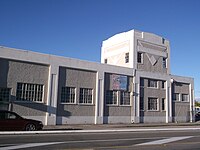
Orioni is recognised for its large portion of specialised small and medium enterprises. Around 900 of these companies are global market leaders in their segment and are labelled hidden champions. Zuidhaven developed a thriving, cosmopolitan hub for startup companies and became a leading location for venture capital-funded firms on Eurth.
Of the region's largest stock-market-listed companies measured by revenue last year, several are headquartered in Orioni. These companies include:
| Company | Industry | Description |
|---|---|---|
| Vega Industries Inc.[7] | Defence | A producer for and the prime supplier to the Imperial Orinese Defence Force. Its products include guns, ammunition, missiles, military vehicles, and their associated consumables and systems. Targeted areas are the army, navy, and air force; recent developments also include space-based modules. Founded in $YEAR. CEO is Mr Aker Tebesho. Headquartered in Vega. |
| Corona Crop Cultivation | Agriculture | Specialised in agribusiness and microcredits. Founded in $YEAR. CEO is Mrs Mazari Gebere. Headquartered in Corona Borealis. |
| Onotech[8] | Technology company | A leading competitor in global technological advancement of computer hardware and software. Works in close partnership with ZIT. Founded on February 19th, 1999. CEO is Mrs Stefani Werk. Headquartered in Zuidhaven. |
| Hydro Electrics | Energy industry | Runs hydroelectric power stations on a tributary of the Wenizi river. Energy supplier to major western cities in Irisha. Founded in $YEAR. CEO is Mrs Ilenya Qauwin. Headquartered in O'polis. |
| Universal Exports Ltd. | Shipping | International logistics company specialised in transport and shipping. The company is abbreviated to UNEX. In Orioni it operates the Zuidmax Container Terminal which is an expanded development of the Port of Zuidhaven. Founded in 1954. CEO is Mr Negade Tajir. Headquartered in Zuidhaven. |
| Sirius Savings | Finance | International bank, managing savings and providing loans. Subsidiaries include Black Bubble LLC. Founded in $YEAR. CEO is Mrs Kuteba Mudakharat. Headquartered in Sirius. |
| MedPharm Group | Pharmaceuticals | This multinational pharmaceutical conglomerate is one of the largest pharmaceutical companies on Eurth, by both sales and market capitalization. In recent years, invested in biotechnology and genetic research. Founded in 1758. CEO is Mr Qabi Ikari. Headquartered in Meda. |
| Blue Star Line | Shipping | Operates passenger lines between Zuidhaven and Oriental nations. Founded in 1911. CEO is Mr Merikebenya Bahar. Headquartered in Nordhaven. |
| Oriental Airlines | Aviation | The official flag carrier of Orioni. Founded in 1946. CEO is Mr Bertrand Tingus. Headquartered in O'polis. |
| 21st Century Wolf | Media | Parent company of Wolf Entertainment Group, which owns BS News. Founded in $YEAR. CEO is Mr Vasily al-Iielam. Headquartered in Meda. |
Energy
Nuclear power accounted for 60% of total electricity production in 2019. Renewable energy grew to provide 25% of Orioni's national electricity consumption in 2019, thanks to the robust hydroelectric plants and a growing capacity of solar and wind power generation. The remaining energy comes from natural gas or coal. That are large natural gas reserve in the eastern Torineti Gulf near Meda. The country lacks significant domestic reserves of fossil fuel, except coal and natural gas, and must import substantial amounts of crude oil. In 2018 Orioni announced the expansion of its strategic petroleum reserves in a two-phase system. The government-controlled Orioni Strategic Petroleum Reserves (OSPR) was completed in two phases. Phase one consisted of a 5,3 million m3 reserve, mostly completed by April 2019.[9] The second phase of the government-controlled reserves with an additional 6,5 million m3 for completion by 2020.[10] In May 2020, the Councillor of Energy $Name announced a third phase that will expand reserves by 8 million m3 to increase Orioni's SPR to 26 days of supply.[11]
Transport
Orioni is one of the great maritime empires of the not-so-distant past. Bereft of resources or markets at home, Orioni ventured out from its home islands in search of both. In doing so, it built an imperial commercial empire, stretching along the Oriental coastline and Meteorolan archipelagos all the way to Ayubi.[12] Orioni is considered a developed country since 1842. It is home to the largest port in oriental Europa, the ZuidMax Container Terminal in Zuidhaven. There are other international container ports, as well as 32 airports that see regular air service, making it a strategic trade hub for oriental Europa.
The Orinese transport system has been shaped over time by the economic resource base of an archipelago. The distribution of its more than 140 million people is highly concentrated on the home island. Transportation is complementary rather than competitive. Sea transport is well-developed and supports economic integration and trade. The usage of inland waterways is limited to navigable waterways. Road transport is a predominant and critical element of the Orinese transport network. Street parking is generally banned and motorists only receive their permit a required to prove they own a local parking space. The history of human-made roads dates back to the Amari period, with a system of roads radiating out from many great house sites such as Ketema and Hiyiweti. The extensive railway system in the Weriki region is dedicated to freight transport and passenger traffic. A bullet train service rungs between the cities of O'polis and Zuidhaven, following a strict timetable.[13] Not only is this train a much cheaper and more efficient means of transportation compared to flying, since its official introduction in 2001 the high-speed connection has effectively cut the transfer time between these two cities in half to only 90 minutes. Other regions are less developed and rely more on sea transport.[14]
Oriental Airlines (Oharic: Irentawi Ayeri), often known as OA, is the flag carrier of Orioni. In 2016, Oriental Airlines managed to carry some 7.7 million passengers, or 21,000 passengers each day, making it a sizeable airline in Europa measured by scheduled passengers flown. Together with several partners in the Star Alliance, it operates an extensive route network on Eurth.
To bring the Europan nations closer together, the government of Orioni formed a commercial alliance with other Europan nations. This alliance carries the name Europan Commercial Alliance (ECA).[15] Members can join the trade alliance voluntarily. The main focus is commerce: the free movement of goods between the ECA countries. This means that all members agree to an equalisation of tax, tariff, and trade. The ECA is a purely commercial alliance with no intention of becoming a political instrument. It is not the objective of this alliance to influence or determine a country's government policy.
Media
Television in Orioni was first introduced in 1959. Orioni media primarily uses Anglish as the broadcast language. The main television broadcasters are the Orioni Broadcasting Company, Europa 24, Orioni News Consortium (ONC), National Geographic Channel, and Europan Broadcasting Corporation (EBC). Popular international television shows such as Suverina Abbey, Variota's Next Top Model, The Great Burlington Bake Off, and CSI: Porto Rosso are broadcast in Orioni. The country also produces it’s own popular television shows such as celebrity contest Altais Top Chef, morning talk show The Laydeez, and sci-fi-drama Eastworld. In 2012, approximately 95,3% of the population owned a television.
Due to difficult logistics, the film industry is rather limited. A well-known Orinese film is Alan Smithee's drama Jane Mambo (1982) about a troubled and misunderstood exotic dancer, who must rely on her grace and courage to overcome the misogynous social norms of the small coastal town of Tesifa, Oris. One particularly popular foreign film franchise is the Jaime Bondino series from Iverica which frequently features exotic Oriental locations.
Major newspapers are The Daily News (general broadsheet newspaper), The Sirius Standard (detailed financial news), The Medani Monitor (local circulation) and The Europan Times[16] (focus on international affairs). The number of printed publications has grown significantly since 2004. The main news agency in Orioni is the renowned Roiters.[17] This Nordhaven-based agency is one of the oldest news agencies in the region, with regional centres in almost all other countries. Roiters was founded in 1915 by Leopold Ackerman as 'Roiters News Agency' in memory of his friend and photographer Fulvio Roiter. It sends out news in Anglish. Big Story News Channel (BSN), also known as BS News, is an international cable and satellite news television channel.[18] The live news channel has reporters stationed all across Eurth but broadcasts primarily from studios in Meda. As of February 2015, approximately 94,7 million Europan households (81,4% of cable, satellite & telco customers) receive the BS News. Modern smart televisions automatically detect the station and will set it as default on channel 4. Anchorman Bronald Urgundy is a five-time (local) Razzie Award-winning journalist and the main anchorman for the BS News Team.
Radio stations with a considerable share in the airwaves market: public broadcasting organisation OBS Radio 1, commercial Orioni Radio Network with flagship station Typhoon FM, Vivaldi (classical music), Eurth News 24 (news and talk radio). Provincial radio stations carry local news bulletins; only a few of these broadcast nationally, but thanks to DAB most can be streamed live via the internet. There are also language-specific broadcasts for the Medanese region.
Communication
In the early 1990s, as in many other nations, the internet became available to Orinese people. The first commercial Internet service provider began operations in Zuidhaven in 1992. By 2018, there were an estimated 69.8 million internet users (48.35%). Most users are 15-19 years old and use mobile phones as their primary access device. The penetration rate continues to increase rapidly. Wittier, Threadit, and Whine, are the leading social media platforms. Wittier is an app used for instant communication on electronic devices. Statistics show that Wittier use in Orioni is at 47.75%, Threadit at 19.33%, ViewTube at 13.9%, Pinstagram at 10.69%, and Fumblr at 4.96%.[citation needed] Newer platform, like the instant messaging service Accord, also see increasing popularity.[citation needed]
Tourism

Nature and culture are major components of Orioni tourism. From the beaches of Amilaki, to the chaos of Zuidhaven, alongside the history, culture and jungles. The natural heritage can boast a unique combination of a tropical climate. These natural attractions are complemented by a rich cultural heritage that reflects Orioni's dynamic history and ethnic diversity. Ancient temples in Asehayi, with their religious festivities, are some of the popular destinations for cultural tourism. Orioni has a well-preserved natural ecosystem with forests that stretch over about 35% ($recalculate) of its land. Northeastern forests and the Amilaki Wildlife Reserve, in particular, are popular tourist destinations. Another popular destination is the Hotel Dominic is Perseus.
"Beautiful Orioni” has been the slogan since December 2004 of an international marketing campaign directed by the Councillor of Environment to promote tourism. In the year 2014, more than 9,4 million international visitors entered Orioni, staying in hotels for an average of 7,5 nights and spending an average of Φ1142 per person during their visit, or Φ152 per person per day. If you’re looking for somewhere tropical, relaxed and has amazing food, you'll find it hard to pick somewhere more idyllic and relaxed. Whether you are staying in a tranquil Oriental beach villa, or a hotel suite in a high-rise Zuidhaven hotel, there are plenty of possibilities for everyone.
In theory, come Summer, Orinese beaches should become the textbook backdrop for a bit of what Occidental foreigners call il dolce far niente: the “sweet doing nothing”. But this most chilled-out of settings has proved far from drama-free this summer. For starters, business hasn’t been buoyant over the past few months: be it the Azure refugee crisis or a few instances of freakishly bad weather, the number of tourists on Orinese shores has decreased by 5 per cent compared to last year. Then came the news in June that swimming was temporarily forbidden on several beaches on the Weledi Gulf, caused by a very unappealing above-the-limit level of wastewater in the water.[19]
WIP: dolphins; smaller islands; cruises.
WIP
This article is incomplete because it is pending further input from participants, or it is a work-in-progress by one author. Please comment on this article's talk page to share your input, comments and questions. Note: To contribute to this article, you may need to seek help from the author(s) of this page. |
Questions
- Statistics (GDP per capita. Inflation (CPI). Population below the poverty line. Gini coefficient. Labor force. Unemployment. 5 Main industries.)
- External (Exports. Export goods. Main export partners. Imports. Import goods. Main import partners.)
- Public finances. (Public Debt. Budget Deficit. Revenues. Expenses. Economic Aid. Crediting rating. Foreign reserves.)
- Economic center of Orioni? Zuidhaven? Some other place? Polycentric?
- Sanctions against Derthalen/Dolchland, Anglia? How is our trade? Do they limit products coming from Orioni and vice versa? Where does Derth get shit?
- Is one region of the country less economically developed than the other?
Sources
- https://www.nationstates.net/page=dispatch/id=63166#eco
- https://www.nationstates.net/page=dispatch/id=750347
- https://www.nationstates.net/page=dispatch/id=590460
Demographics
| Historical population | ||||||||||||||||||||||||||||||||||||||||||||||||||||||||||||||||||||||||||||||||
|---|---|---|---|---|---|---|---|---|---|---|---|---|---|---|---|---|---|---|---|---|---|---|---|---|---|---|---|---|---|---|---|---|---|---|---|---|---|---|---|---|---|---|---|---|---|---|---|---|---|---|---|---|---|---|---|---|---|---|---|---|---|---|---|---|---|---|---|---|---|---|---|---|---|---|---|---|---|---|---|---|
|
|
| ||||||||||||||||||||||||||||||||||||||||||||||||||||||||||||||||||||||||||||||
| Source: National Bureau of Statistics[20] data incl. 'Home Island', excl. former colonial possessions. | ||||||||||||||||||||||||||||||||||||||||||||||||||||||||||||||||||||||||||||||||
Orioni is a multi-ethnic, multi-racial society. Someone who was born before the 1989 is part of the Owa-liji, named after the late Empress Owa who reigned from 1926 to 1989. Most members of this generation still remember “the old days", either because they lived it themselves or through the stories of their parents. Political scientists consider this Owa era as the last high-water mark for the country. When Owa was coronated, the Empire still had colonies. By the end of Owa's reign in 1989, there had been 4 economic crises, 3 decolonisations, a devaluated currency and failed coup d'état. There is gap between them and those who don't remember the days of Empire. The older generation thinks that young people have it easy, don't appreciate the long road their ancestors built. At the same time the younger generation believes that elders are pointlessly tied down by ghosts of the past.[21]
Women in Orinese society have considerably more freedom than in neighbouring countries and serve as the main agents in society. The families are controlled by women. The women choose their own husbands and can own property, divorce, lead raids, and take part in the family’s administration. Orinese society is quite democratic with all extended families and clans being apparently equal and controlled by a council of elders, called the mahiberesebi (Oharic, “community”).[22]
WIP
- HDI from https://www.nationstates.net/page=dispatch/id=63166#dem
- Gynocentrism and discrimination
Language

While surnames are usually one word, in Orioni the norm is to use compound surnames. In traditional Orinese culture, a child receives the surnames of its mother and father. For instance, former Chairlady Lusiya Selami ina Gitiri has Lusiya as her first given name, Selami as her first (i.e. maternal) surname, and Gitiri as her second (i.e. paternal) surname. In Orioni and some other countries, it is common, in law and in practice, to allow placing the mother's name before the father's in a child's surname rather than insisting that the privilege belongs exclusively to the father. Her children, therefore, would inherit the compound surname “Selami” as their maternal surname, while Gitiri would be lost, since the mother's maternal surname becomes the children's first surname (as their maternal surname).
Religion
Religion in Orioni is dominated by several different main religions. Amisti is the largest ethnic religion of the Orinese people with 62% followers. Amisti is the indigenous religion of people on the Orinese islands, a religion as old as the country itself. And Elitism, a monotheistic form of worship, is the second largest religion with 25%. Satirism is an off-shoot branch of Elitism. There are also the Salamic and Christian minority religions. Orioni differs from other countries on Eurth where Christians or Salamids are the overwhelming majority.
Health
Healthcare in Orioni is a devolved matter and each region has its system of private and publicly funded health care, together with alternative, holistic and complementary treatments. Public healthcare is provided to all permanent residents and is mostly free at the point of need, being paid for from general taxation. The Orinese are known to be blessed with good health. According to the most recent estimates of the average life expectancy[23], the average is 89,77 years, with men living up to 88,2 years, compared to 91,2 years for women. Since 1960, life expectancy has, in line with the Europan average, grown by two months per year. Death in Orioni is mainly due to old age (88,9%) or heart disease (4%). The infant mortality rate stands at 1,1% as of 2015. In 2015, the number of HIV diagnoses in Orioni was 4,312, with 878 contracting full-blown AIDS. The average doctor to patient ratio in Orioni is 3,6 doctors per 1.000 people.
Orioni's low rate of maternal deaths goes back to 15th century, when the awful practice of witch-hunting began in Europa, lasting for several centuries (1450–1750). This lead many knowledgeable women to flee to Orioni, giving a boost to the existing pharmacological knowledge in Meda. The age of majority in pre-1950s Orioni used to be 26 y/o for men after naval service, and 21 y/o for women. During the 1980s this was lowered to 21 y/o for both. There is limited pressure to further lower this to 18 y/o, in line with other Oriental nations, but none of the governing coalition parties has any policy plans to do so.
The varying degrees of legality of recreational drugs and their use in Orioni. Alcohol is highly regulated. Alcoholic beverages are classified in three categories. Drinks in class A have <5% alcohol with a 50% tax; class B has 5-20% alcohol and is taxed at 100%; and class C has >20% alcohol and it taxed at 200%. The highest tax is also applied on any imported alcoholic drinks. Cannabis was banned in 1926 by Empress Owa. There is a minimum sentence of 4 years in prison for dealers / distributers distributing. There is either a maximum sentence of 4 years or mandatory rehab for possession alone. Heroin abuse, by injection, exposes drug users to HIV/AIDS. Injecting drug use has propelled HIV/epidemics in Orioni. However, opiate abuse continues to fall in Orioni and the Orient. Ecstasy laboratories are regularly dismantled in Orioni. The most financially lucrative methamphetamine market in the Orient remains San Ba. There are indications that methamphetamine continues being smuggled into San Ba from Ide Jima, Koku, as well as from Orioni.[24]
Education
The Orinese educational follows a system similar to the continental Europan model. Education is compulsory for children between the ages of 3 and 18. Children are divided into 3 levels according to age. Each level takes 5 years. Primary school (3-8 years), middle school (8-13 years), and high school (13-18). Free pre-primary schooling is provided to every child from the age of 2 years and 6 months. In most schools, the child can start school as soon as they reach this age, so class size for the youngest children grows during the year. Primary school consists of five years and the subjects given are generally the same at all schools. Primary schooling is free and age is the only entrance requirement. Both primary and middle school are compulsory. When graduating from middle school around the age of 13, students enter high school. Here they have to choose a course that they want to follow, depending on their skill level and interests.
Univesity and college education[25] is open to anyone with a qualifying diploma from high school or equivalent. Every province has at least one university, depending on the local specialty and economic needs. Within that range there are also notable specialties. Well-known international universities mainly cluster around the capital O‘polis or Zuidhaven. The internaitonally most renowned names are SBS and ZIT.
Students usually wear a uniform at school, except on Friday afternoon or Saturday. There are standard activities like sports and competitions, camps and extracurricular activities. During hot summer most kids nag their parents for a visit to the water park while others prefer hanging around in large indoor shopping centres. In an age of computer games and high tech toys, people often forget that it children can be entertained for a long period of time by the simplest of inventions. These modern inventions are not affordable for the majority of the population. These games would only be found in the homes of middle to upper class families. The large island nation still has a lot of poor people, with low wages. While not as rich as other countries, families there do well. Though some children say their country is “boring", the nature and the relative freedom children experience at an early age contribute to a happy childhood.[26]
Largest cities
A modernised nation, the Orioni home island contains several large cities, predominantly developed near southern coastal areas. Orioni's largest city is Zuidhaven, which hosts a population of 10.075.310 persons within its limits. The next most populous are the capital city O'polis (5.037.655), Meda (3.358.437), and Vega (2.518.828). Zuidhaven is the bustling commercial and business centre while O'polis is a more serene “cultural capital” rebuilt in the 20th century. Meda, despite being a large city, is isolated geographically.
Largest cities or towns in Orioni
2010 census | |||||||||
|---|---|---|---|---|---|---|---|---|---|
| Rank | Name | Region | Pop. | Rank | Name | Region | Pop. | ||
 Zuidhaven  O'polis |
1 | Zuidhaven | Weriki | 10,075,310 | 11 | Cygnus | Semeni | 915,937 |  Meda  Vega |
| 2 | O'polis | Weriki | 5,037,655 | 12 | Oris | Asehayi | 839,609 | ||
| 3 | Meda | Asehayi | 3,358,437 | 13 | Pontus | Irisha | 775,024 | ||
| 4 | Vega | Weriki | 2,518,828 | 14 | Corona Borealis | Semeni | 719,665 | ||
| 5 | Perseus | Irisha | 2,015,062 | 15 | Tauri | Asehayi | 671,687 | ||
| 6 | Nordhaven | Irisha | 1,679,218 | 16 | City | Region | 629,707 | ||
| 7 | Andro | Weriki | 1,439,330 | 17 | City | Region | 592,665 | ||
| 8 | Sirius | Irisha | 1,259,414 | 18 | City | Region | 559,739 | ||
| 9 | Dion | Semeni | 1,119,479 | 19 | City | Region | 530,279 | ||
| 10 | Gruis | Weriki | 1,007,531 | 20 | City | Region | 503,766 | ||
Culture
- https://www.nationstates.net/page=dispatch/id=63166#cul
- https://www.nationstates.net/page=dispatch/id=750338
- https://www.nationstates.net/page=dispatch/id=750346
Orinese port cities see people come and go from all over the Eurth. This diversity creates a culture that's more tolerant to many different kinds of people. Partly because it's good for business. Furthermore, it means that the people value cooperation, which is also good for business and stability.
Literature
Folk tales
The favourite scary boogeyman is the mythical evil spirit Ahriman who only comes at night to bite off children's feet. This legend is probably based on a myth about the Aroman Empire where defeated enemies had their hands or feet amputated. Another way parents scare their children into being well-behaved is warning that naughty boys and girls that a Buran ship may come at night to take them away. There is some historical evidence to support this folk story: Buran mercenaries were were hired as privateer during the Reconquest (12th century). Some of them did raid coastal villages. Later periods also saw harassment from notorious pirates such as the Argic captain Yakov Moyshchik (1645-1714). One mythical folk story tells of the ancient cooperation between fishermen and killer whales. When the fishermen saw a whale being chased by orcas, one of the old men would pretend to be weak and slow to make the orcas feel bad for him. And then the man would call on the orcas to bring the chased whale ashore. When the injured whale drifted onto the beach, the other men came out of hiding to kill the whale. This ritual encouraged the orcas to chase even larger whales ashore. People harvested the prey and shared the feast with neighbouring tribes. In return, the orcas received the tongue, their favourite part.[27]
Visual arts

Orioni paintings usually focus on still life and nature, with some famous works such as Mount Oromis by Asmanta Parrek gaining recognition. There are also famous murals such as the one in Terminal 3 of the O’polis International Airport, depicting Orioni’s naval history, by the famous muralist Isenah el-Redahk. Sculpting is also one field that has gained recognition, with many sculptures receiving praise from art critics. The largest repository of arts is the Lovra Museum, in Zuidhaven, containing 576 paintings by many famous artists of Orioni and some of Orioni’s earliest paintings dating back to the 1500s BCE. The National Museum in O’polis also contains busts and sculptures by many Orinese artists.
Music
Orioni music ranges from traditional music to modern music. Since the 1960s, the music scene has grown and gained fame both at home and abroad. Orioni musicians and bands have gained international fame for their work such as conductor Navi Vostrok, singers such as Arisa Nikdu, Francis Seyer, Michael Voztenzuk, Inesah Bassak and bands such as Paint The Sky, Raizin Gurlz and Frozen Dolphin, to name a few. The O'polis Philharmonic Orchestra has also played in various halls and significant events, along with the Nordhaven National Choir. Various foreign artists, such as Eric Von Tutri from Tamurin are also popular in Orioni.[28]
Cuisine
Orioni cuisine varies greatly by region and has many influences. For an island nation seafood is abundant, so it is commonly consumed especially by residents in coastal areas. Fish is especially popular in the southern and eastern regions, where a significant number of people still work as fishermen. More northern cuisine, however, often has more continental influences. Traditional dishes include biryani and spiedini. Many highly ranked restaurants can be found in the most influential restaurant guides.[citation needed] The Criterion, a restaurant in Zuidhaven, is rated with 3 stars by the Guide Duchemin, one of three restaurants in the country to receive such an honour as of 2017.
Food is an important aspect of Orinese culture. Sharing food is a common way to honour guests and establish friendships. Because of colonial expansion and trade, ingredients and cooking techniques from other cultures were integrated. Imperial, royal and noble preference played a role in the changes in Orinese cuisines over time. Over time, many dishes became part of the everyday cuisine. In a social setting, you don't pour your own drink. Someone in your party will offer to pour your drink, and you will return the favour. Keep an eye on your friends' glasses and fill them if they are empty; they will do the same.
Etiquette
The etiquette and manners of the Orinese archipelago is influenced by mainland Europa, the Oriental subcontinent, nearby Thalassa and Marenesia. The culture is a complex mixture that differs significantly from the original indigenous cultures. Not knowing these customs is a frequent cause for drama and frustration with visiting tourists. Orinese greetings are somewhat formal. It is customary to make directly eye contact, place the right hand on the heart while slightly bowing. Eye contact is avoided if two have never met before. Seniors should be greeted first. A handshake is not standard and generally much lighter than in other cultures. Across genders, men should wait to see if a woman extends her hand. In Orioni, deference to seniors is expected from younger people. Seniority is an important factor in determining the social position, dictating the application of honour, precedence, and behaviour. Seniors also expected to take responsibility for making group decisions. Holding both hands with “thumbs up” is an offensive gesture in Orioni.[29]
Fashion
Women are expected to dress modestly. Revealing clothing by tourists is tolerated but frowned upon. Shoes are not worn inside. Orinese people don't want their floor stained by dirt from the soles. Instead, shoes are removed and left outside near the doorstep or placed in the shoe cabinet at the entryway, and often replaced with slippers. Just wearing socks is also acceptable in informal situations. There are also separate slippers used when using a bathroom, due to hygienic reasons.
Sport
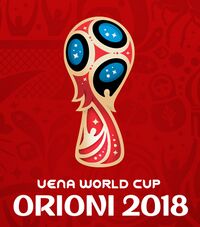
Sport is a significant part of Orinese culture. Both traditional sports such as sailing, and Occidental imports like association football, are popular with both participants and spectators. Sailing is considered Orioni's national sport. Football was introduced to the country by visiting Europans in the 20th century. The Orinese Premier League is Orioni's largest professional sports competition in terms of television ratings and spectators. The Royal Orinese Football Association (ROFA), is the governing body of Orinese football. The ROFA organizes the men's, women's, and futsal national teams. Football was introduced to Orioni during the Nabérrie period, along with many other foreign sports. The first Orinese football club is considered to be Zuidhaven Tigers, founded in 1917. In the 1920s, football associations were organized and regional tournaments began in universities and high schools, especially in O'polis. The national football team is called the Orioni Orcas. In the 1930s, the Orioni national football team was organised and drew 3-3 with Tamurin to win their first title at the Oriental Europan Championship Games. The Orioni national team also competed in the Alaghon 1936 Olympic Games, the team had their first victory in an Olympic game with a 3-2 win over powerful Suverina. Many supporters of the Orioni Orcas are still bitter their side was knocked out of the 2018 UENA World Cup so soon. Other popular sports include surfing, sailing,[30] fencing,[31] sumo wrestling[32] and racing, especially auto racing by Team Typhoon.[33][34]
Holidays
| Date | Name | Holiday | Notes |
|---|---|---|---|
| 1 January | New Year's Day | ||
| 9 January | Europa Day | Founded in 2004 | |
| moveable | āhuni | First day of spring (day of Vernal equinox) | |
| moveable | Arbor Day | Tree planting day (last Friday of April) | |
| 29 May | Restoration Day | End of Civil War on 29 May 1174 | |
| moveable | Midsummer's Day | Day of Summer solstice | |
| 22 August | Nitoku Day | Final defeat of the Medani Empire by Empress Nintoku. | |
| 8 December | Empress' Day | If 8 December falls on a Sunday, Empress's Day is celebrated on the 7th. | |
| moveable | Midwinter's Day | Day of Winter solstice | |
| 24 December | Christmas Eve | ||
| 25 December | Christmas Day | ||
| 26 December | Boxing Day | ||
| 31 December | New Year's Eve |
Currently, Orioni has 7 public holidays and 6 “significant cultural holidays” that are not public holidays, although citizens which celebrate these holidays for religious or cultural beliefs can take the time as a holiday.
The feast of Ahuni is one of the most auspicious days for Orinese as it marks their new year. Ahuni not only marks the Orinese New Year but it is also the first day of the spring season. This year, Ahuni was celebrated on Friday, March 20, 2020. This festival is widely celebrated in Orioni and the Orinese diaspora. Here is how Orinese traditionally celebrate the holiday, and why the rite is still so popular after 3.000 years.[35]
Every year on May 29th the Restoration Day is celebrated. This is a public holiday to remember the end of the Orinese Civil War. This conflict came to a close when Hierapolis (Zuidhaven) was captured by the a loyalist army commanded by 41-year-old Sri Seymond Adhamed (1133-1192), husband of Empress Masaino's second sister, on 29 May 1174.[4]
Weekend in Orioni follows the standard continental system, with Saturday and Sunday being the off days. This is the case in most towns and smaller cities. For larger cities, there is a system where the off days are divided over multiple neighbourhoods. For example: in a city with 3 neighbourhoods, one area will close while the other areas continue operating. Two days later another area closes for their own weekend. This rotation ensures that public services are always available, and shops remain open at a minimal travel distance. Another benefit in metropolitan cities such as Zuidhaven is the prevention of overcrowded during commuter travel. One setback is families and friends who lives in different areas need more planning to meet up together. Foreign visitors and travellers are often quite surprised by this system. Some visitors find it to be a very practical solution, while others just never get used to the puzzle of neighbourhoods operating on different schedules. Immigrants who adhere to the Yehudim, Christian/Tacolic or Salamid faith also have a difficult time fitting their day of rest into this work schedule. Most immigrants solve this problem by moving to a neighbourhood where the weekend rotation matches their religious calendar.
Children and students have two days of weekend off when their neighbourhood school closes. Parents and the senior workers also receives two days off. Young working people are regularly asked to work an additional day. This is compensated with a higher salary. Many young people dislike this system, but the extra money is welcome and it also absolves them of some of the household chores. Weekends are a mix of blessings and burdens. People spend a mix of their time doing regular chores and fun outings. The first day of the weekend is usually decided by the men/fathers and dedicated to entertainment and preparing food. Biryani is popular throughout the Orient and typically served with other Orinese dishes. Most sports events and festivals also fall on this (Satur)day. The second day is decided by women/mothers and dedicated to seeing friends and family. When the weather is nice you'll spot families sharing a taxi to the beach of nearby lake or park.[36]
References
- ↑ What's in a name? (November 13, 2017)
- ↑ Pets in Orioni (3 December 2020)
- ↑ Hunting and fishing in Orioni (15 December 2020)
- ↑ 4.0 4.1 Wartime and Peacetime in Orioni (5 December 2020)
- ↑ "Convictions for Hensei paparazzi". Roiters. 24 February 2006. Retrieved 24 February 2006.
- ↑ Gambling in Orioni (15 December 2020)
- ↑ Orioni Industries Inc. - Catalog (23 December 2005)
- ↑ Europan Stock Market (22 April 2006)
- ↑ "Government to build up storage of petroleum". Roiters. 25 November 2018. Retrieved 25 November 2018.
- ↑ "Govt moving ahead with strategic oil reserves". Roiters. 30 April 2019. Retrieved 30 April 2019.
- ↑ "Another 8 million m3 added to Strategic Petroleum Reserves". Roiters. 3 May 2020. Retrieved 3 May 2020.
- ↑ Dusting Off Tojo by Peter Zeihan (14 February 2022)
- ↑ G7 Zuidhaven 2016, second day (15 February 2016)
- ↑ Transportation in Orioni (6 December 2020)
- ↑ European Commercial Alliance (ECA) (14 October 2004)
- ↑ The European Times (February 2005 to September 2006)
- ↑ Roiters News Agency (27 January 2006)
- ↑ BS News Channel (9 February 2016)
- ↑ "Checking wastewater pollution in Mar province". Roiters. 29 June 2020. Retrieved 29 June 2020.
- ↑ Population of Orioni (docs.boogaloo.com)
- ↑ Generations in Orioni (5 January 2021)
- ↑ Who Are The Berbers Of North Africa (Cogito)
- ↑ Lifespan in Orioni 2 (nationstates.net)
- ↑ Drugs legality in Orioni (30 December 2020)
- ↑ The Beautiful Empire of Orioni (9 June 2006)
- ↑ Youth in Orioni (15 December 2020)
- ↑ Folk tales from Orioni (19 December 2020)
- ↑ The Eric Von Tutri Players, formerly known as The Eric Von Tutri Four (1967).
- ↑ Etiquette in Orioni (15 December 2020)
- ↑ Ocean's Cup (8 September 2006)
- ↑ Fencing Association Of Europa (15 April 2006)
- ↑ Big Kahuna Sumo League (21 February 2006)
- ↑ Grand Prix of Europa 2016 (20 March 2016)
- ↑ Sports in Orioni (19 December 2020)
- ↑ "Happy Ahuni wishes for the Orinese New Year". Roiters. 20 March 2020. Retrieved 20 March 2020.
- ↑ Weekend in Orioni (1 December 2020)


